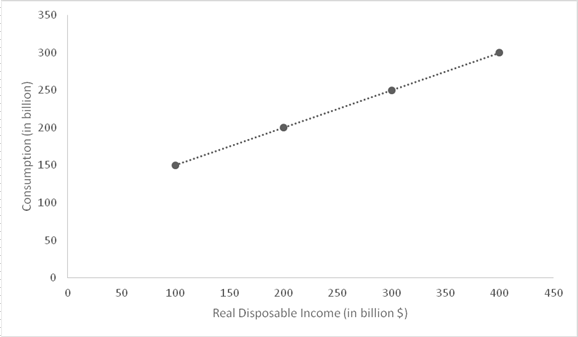
Sub- Part
A
Based on the data, Graphical representation of consumption function, with consumption spending on vertical axis and disposable income on horizontal axis.
Sub- Part
A
Explanation of Solution
(a) − Following graph shows the consumption function in an economy.

Sub- Part
Introduction: Consumption function represents the functional relationship between total consumption and gross
B
Based on the data, to find:
Slope, if consumption function is a straight line
B
Explanation of Solution
In case of a straight line, slope of the line remains constant or same everywhere along the line. So, if the consumption function is a straight line then its slope will remain same everywhere along it. The difference between two level of income and consumption will be constant. The slope of consumption function can be calculates as follows −



Thus, the slope of given consumption function is 0.5.
Sub- Part
Introduction: Consumption function represents the functional relationship between total consumption and gross national income. Consumer spending depends on three factors: disposable income (Yd), autonomous consumption (a), i.e. when income is zero, and induced income (b), i.e. the percentage of extra income that is spent. The formula for the same is C = a + b*Yd.
C
Based on the data,
Find the Savings at each level of income and the slope when the saving function is a straight line.
C
Explanation of Solution
If the saving function is a straight line then its slope will remain constant. Difference between two level of income and saving will remain constant along the saving function. As saving function is a straight line, change in saving and income would be the same. Thus, the slope of saving function would be:



| Real Disposable Income (in billion $) | Consumption Expenditure (in billion $) | Savings (in billion $) |
| 100 | 150 | -50 |
| 200 | 200 | 0 |
| 300 | 250 | 50 |
| 400 | 300 | 100 |
Introduction: Consumption function represents the functional relationship between total consumption and gross national income. Consumer spending depends on three factors: disposable income (Yd), autonomous consumption (a), i.e. when income is zero, and induced income (b), i.e. the percentage of extra income that is spent. The formula for the same is C = a + b*Yd.
Want to see more full solutions like this?
- Some people say that since inflation can be reduced in the long run without an increase in unemployment, we should reduce inflation to zero. Others believe that a steady rate of inflation at, say, 3 percent, should be our goal. What are the pros and cons of these two arguments? What, in your opinion, are good long-run goals for reducing inflation and unemployment?arrow_forwardExplain in words how investment multiplier and the interest sensitivity of aggregate demand affect the slope of the IS curve. Explain in words how and why the income and interest sensitivities of the demand for real balances affect the slope of the LM curve. According to the IS–LM model, what happens to the interest rate, income, consumption, and investment under the following circumstances?a. The central bank increases the money supply.b. The government increases government purchases.c. The government increases taxes.arrow_forwardSuppose that a person’s wealth is $50,000 and that her yearlyincome is $60,000. Also suppose that her money demand functionis given by Md = $Y10.35 - i2Derive the demand for bonds. Suppose the interest rate increases by 10 percentage points. What is the effect on her demand for bonds?b. What are the effects of an increase in income on her demand for money and her demand for bonds? Explain in wordsarrow_forward
- Imagine you are a world leader and you just viewed this presentation as part of the United Nations Sustainable Development Goal Meeting. Summarize your findings https://www.youtube.com/watch?v=v7WUpgPZzpIarrow_forwardPlease draw a standard Commercial Bank Balance Sheet and briefly explain each of the main components.arrow_forwardPlease draw the Federal Reserve System’s Balance Sheet and briefly explain each of the main components.arrow_forward
- 19. In a paragraph, no bullet, points please answer the question and follow the instructions. Give only the solution: Use the Feynman technique throughout. Assume that you’re explaining the answer to someone who doesn’t know the topic at all. How does the Federal Reserve currently get the federal funds rate where they want it to be?arrow_forward18. In a paragraph, no bullet, points please answer the question and follow the instructions. Give only the solution: Use the Feynman technique throughout. Assume that you’re explaining the answer to someone who doesn’t know the topic at all. Carefully compare and contrast fiscal policy and monetary policy.arrow_forward15. In a paragraph, no bullet, points please answer the question and follow the instructions. Give only the solution: Use the Feynman technique throughout. Assume that you’re explaining the answer to someone who doesn’t know the topic at all. What are the common arguments for and against high levels of federal debt?arrow_forward
- 17. In a paragraph, no bullet, points please answer the question and follow the instructions. Give only the solution: Use the Feynman technique throughout. Assume that you’re explaining the answer to someone who doesn’t know the topic at all. Explain the difference between present value and future value. Be sure to use and explain the mathematical formulas for both. How does one interpret these formulas?arrow_forward12. Give the solution: Use the Feynman technique throughout. Assume that you’re explaining the answer to someone who doesn’t know the topic at all. Show and carefully explain the Taylor rule and all of its components, used as a monetary policy guide.arrow_forward20. In a paragraph, no bullet, points please answer the question and follow the instructions. Give only the solution: Use the Feynman technique throughout. Assume that you’re explaining the answer to someone who doesn’t know the topic at all. What is meant by the Federal Reserve’s new term “ample reserves”? What may be hidden in this new formulation by the Fed?arrow_forward

 Essentials of Economics (MindTap Course List)EconomicsISBN:9781337091992Author:N. Gregory MankiwPublisher:Cengage Learning
Essentials of Economics (MindTap Course List)EconomicsISBN:9781337091992Author:N. Gregory MankiwPublisher:Cengage Learning Brief Principles of Macroeconomics (MindTap Cours...EconomicsISBN:9781337091985Author:N. Gregory MankiwPublisher:Cengage Learning
Brief Principles of Macroeconomics (MindTap Cours...EconomicsISBN:9781337091985Author:N. Gregory MankiwPublisher:Cengage Learning







